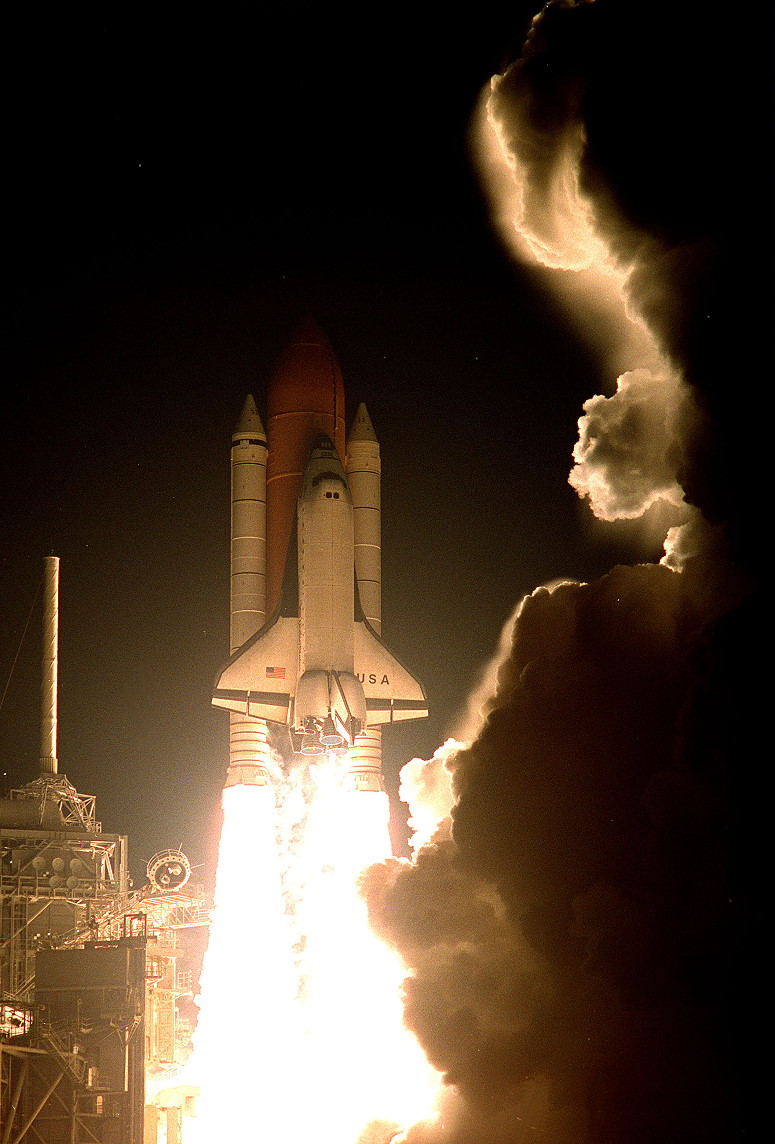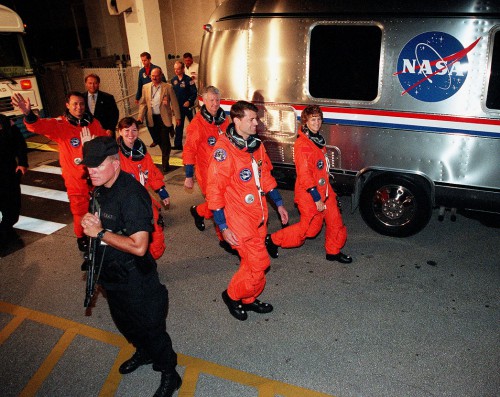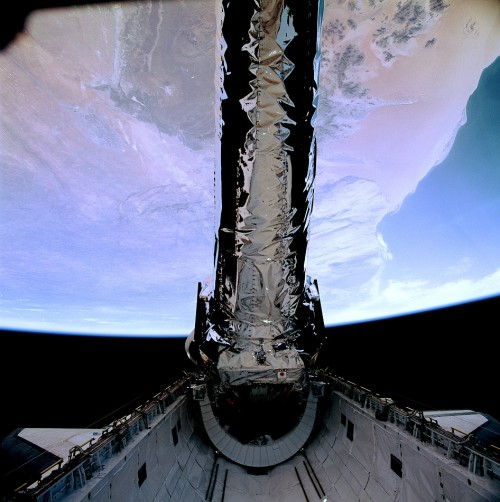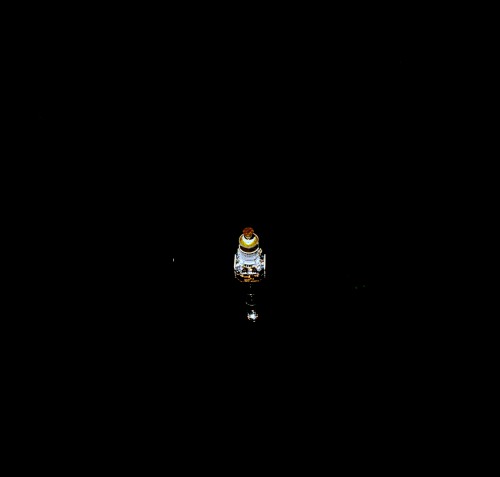
Fifteen years ago, this week, the first woman ever to lead a space mission was launched aboard Shuttle Columbia to deliver NASA’s $1.5 billion Chandra X-ray Observatory—the third of a quartet of “Great Observatories” to observe the Universe across most of the electromagnetic spectrum—into a highly elliptical orbit. As described in yesterday’s AmericaSpace history article, the demands of Eileen Collins’ STS-93 mission were fraught with risk; risk which she and her crewmates, Jeff Ashby, Catherine “Cady” Coleman, Steve Hawley, and Frenchman Michel Tognini, were keenly aware of. However, as their July 1999 liftoff drew nearer, they intuitively knew that rising from Earth into orbit was arguably the most hazardous journey of any mission. Not until they actually began that journey, however, would they truly realize how hazardous it really was.
Already long-delayed, Columbia’s launch was twice postponed before the STS-93 crew finally made it into space. On 20 July, the countdown was halted at T-7 seconds, when high concentrations of hydrogen gas were detected in the shuttle’s aft compartment. It was a particularly dangerous moment, coming milliseconds before the ignition of the three main engines. If the halt had been called after ignition, the result would have been a risky on-the-pad abort and probably a month-long delay in readying the vehicle for another attempt. The cause of the problem seemed to be a hydrogen “spike,” which a sharp-eyed launch controller spotted briefly peaking at 640 parts per million, or double the maximum allowable “safe” limit. During the crisis, the mood in the Launch Control Center (LCC) at the Kennedy Space Center (KSC) was tense, as indicated by voices on the communications loop. Sixteen seconds before launch, it seemed, one of two gas detection systems indicated the 640 ppm hydrogen concentration, and, even though the second device showed a more normal level of 110-115 ppm, launch controller Ozzie Fish radioed his colleague, Barbara Kennedy, at the Ground Launch Sequencer (GLS) console to manually stop the countdown. To the assembled spectators at KSC listening to spokesman Bruce Buckingham’s commentary, all seemed normal at first.
“T minus 15 seconds,” announced Buckingham, then “T minus 12 … 10 … nine … ”
Inside the Launch Control Center, Fish urgently radioed: “GLS, give cutoff.”
“ … eight, seven … ” continued Buckingham.
“Cutoff. Give cutoff!” interjected NASA Test Director Doug Lyons.
“Cutoff is given,” replied Kennedy at the GLS console.
“We have hydrogen in the aft [compartment],” Fish reported, “at 640 ppm.”
By now past what would have been a “normal” ignition of the main engines, Buckingham announced the disappointing news to the public. Back in the LCC, with hydrogen concentrations decreasing back toward normal levels, Lyons polled his team, asking them if any emergency safing procedures were needed, such as evacuating the crew from the shuttle, and was told that this was unnecessary. Within 10 seconds of the call for cutoff, the indication of high hydrogen levels had dropped to 115 ppm. Engineers would later blame the problem on faulty instrumentation and flawed telemetry. Although disappointing, the abort had, at least indirectly, shown that NASA was not making special provisions to get STS-93 away on time for the sake of several high-level spectators in the audience.

Eileen Collins’ presence on the crew, as the first woman ever to command a space mission, had dominated the news. Sitting in the VIP area at KSC was none other than First Lady Hillary Clinton, her daughter Chelsea, and representatives of the United States’ women’s football team. Clinton had formally announced Collins’ assignment to command STS-93 in March 1998 at a press conference in the Roosevelt Room at the White House. For Collins herself, the assignment was representative of having worked her way through the ranks, just like the male shuttle pilots, but for Clinton it was a public relations boon. In fact, some observers remarked that the naming of a shuttle commander from the White House was rare, if not unprecedented.
“Eileen’s just trying to do her job,” said Collins’ crewmate Cady Coleman in a pre-flight interview. “At the same time, I’m actually very excited about the historical significance—not for Eileen, not for me, but for the little girls out there. It’s really bringing home the fact to them that Eileen can do what she has set out to do. If all of us can become astronauts, it will help them to realize that the world can be theirs.” Steve Hawley, who sat on the astronaut selection board in late 1989, which ultimately picked Collins for training, remembered that it was obvious back then that she would possibly become the first female shuttle commander. “All of us that were part of that decision,” he said, “take pleasure in seeing it happen. As Eileen said herself, I think another opportunity is clearly available to young girls growing up.” Added pilot Jeff Ashby, who was making his first shuttle flight on STS-93: “Eileen has made me feel very comfortable and treated me not like a rookie, but as somebody who has flown before and I respect her for that.” For Michel Tognini, the wind of change carried even greater significance. When he began his French Air Force career, his superiors doubted that women could even fly aircraft. “Just recently,” he told a NASA interviewer in mid-1999, “I saw in the French Air Force newspaper that we have the first female French fighter pilot, even though we said 30 years ago that it would never happen. Never say never.”
Collins likened her leadership style to the flavor of a family. “It was important for me as a commander to learn what their talents and interests were,” she said of her crew. “With that, we were able to decide who would do what duties on the flight, keeping in mind that we would be able to change that later, if we found that we needed to spread the workload around a little bit better. As we started working eight to 16-hour days together, we really started to become a family. We got to know each other so well that we became like brothers and sisters. That’s one of the strengths I see in my crew. We listen to each other, we get along well, we really understand and can focus on the mission and when we make decisions for the mission, we do what would make it most successful. One thing that comes to mind is how we work together when we do simulations and we’re given malfunctions. You really get to see how people work under stress and you really get to know each other that way. That’s why it’s so important to train together. You need to know each other really well when you go up on a mission like this one.”
Yet the issue of being the first woman to command a space mission was not lost on Collins. Nor did she forget the other female giants, upon whose shoulders she stood. “I wouldn’t be sitting here today if it weren’t for all the people who’ve gone before me and set the stage to bring women into aviation,” she explained before the launch. “In the beginning of the century, it took a lot of courage to fly as a woman, when that really wasn’t a woman’s place. During World War II, there were the Women Air Force Service Pilots and the women who ferried aircraft. In the late 1950s and early 1960s, women competed to be astronauts. In the later 1960s, we started getting more women in the military. In the 1970s, women were offered the opportunity to fly in the military, active duty. That’s when I first became interested in flying. We had our first women selected as astronauts in 1978. Since then, we’ve had more and more women become astronauts. There are three women shuttle pilots now, including me.”

The 20 July launch scrub demonstrated that NASA was unwilling to compromise safety to get Columbia off the ground, even with the First Lady in attendance. Fortunately, the fact that the main engines had not ignited meant that another attempt could be made on the 22nd. A third opportunity was also available on the 23rd, but after that a three-week delay until mid-August would be unavoidable, because the U.S. Air Force had scheduled a major upgrade of its tracking assets on the Eastern Range. In eager anticipation of another attempt on 22 July, eight middeck payloads were removed and serviced and hydrogen sensors in the aft compartment were recalibrated. Additionally, the hydrogen igniters—the system that cleared unburned hydrogen from beneath the engines, ahead of ignition—was replaced. The second effort to get STS-93 airborne also seemed afflicted by misfortune when lightning strikes were recorded, just 3 miles (5 km) from the launch pad. According to flight rules, no lightning was permitted within a radius of 7.5 miles (12 km). The countdown was held at T-5 minutes, in the hope that conditions might improve, but when they failed to do so, the attempt was scrubbed.
“Eileen, we gave it our best shot with this storm today,” said Doug Lyons, “but it didn’t agree with us, so our best bet is to give it another try another day.”
“Okay, CDR copies,” replied Collins, “and we though you guys did a great job tonight. We’re proud of the work and the crew will be ready to go at the next opportunity.”
NASA managed to convince Boeing to postpone a scheduled Delta II launch from nearby Cape Canaveral Air Force Station in order to give STS-93 another opportunity on 23 July. A safe launch was paramount, and former astronaut Don McMonagle, then serving as head of the Mission Management Team, noted that STS-93 would slip until 18 August if this third attempt was scrubbed. In the late evening of 22 July, Collins and her crewmates clambered back aboard Columbia. Right on time, and true to form, Columbia sprang from Pad 39B at 12:31 a.m. EDT on the 23rd, turning night into day across the marshy Florida landscape.
However, the commentator’s excitement-tinged announcement—“We have ignition and liftoff of Columbia, reaching new heights for women and X-ray astronomy”—masked a serious problem brewing in the shuttle’s main engines. It came to the attention of Collins and Ashby five seconds after leaving the pad, when they noted a voltage drop on one of the electrical buses. This caused one of two backup controllers on two of the three engines to abruptly shut down. The third engine was unaffected by the problem, and, luckily, all three performed nominally, boosting Columbia into a 155-mile (250 km) orbit, inclined 28.45 degrees to the equator. Nonetheless, the scare was significant. On no other mission had a shuttle crew come so close to having to perform a Return to Launch Site (RTLS) abort landing. Had the primary controllers, which immediately assumed critical command, also failed, an engine failure was likely and that would have required Collins to wait for the separation of the twin Solid Rocket Boosters (SRBs), flip Columbia over, fly “backwards” at 10 times the speed of sound in order to bleed off speed, then head back west, jettison the External Tank (ET), and guide the orbiter down to the Shuttle Landing Facility (SLF) runway … all under the cloak of darkness.

“We were prepared for that,” she said later. “We were listening for the engine performance data calls [from Mission Control] on ascent. This crew would have been ready to do whatever was needed.” Fortunately, Columbia made it safely into space, but was travelling at 14.8 feet per second (4.5 meters/sec) slower than expected. Although this discrepancy was tiny in view of her 17,400 mph (28,000 km/h) orbital velocity, it was enough for puzzled engineers to question whether there might have been a 4,000-pound (1,800 kg) shortfall in the liquid oxygen pumped into the ET before liftoff. NASA confirmed on 24 July that the loading of propellants had been done correctly, although it would become part of the investigation into the electrical short. Analysis of still video imagery during the STS-93 ascent also revealed another problem: a leak of hydrogen gas from one of the main engines. The images, particularly those from cameras mounted on Pad 39B, revealed a narrow, bright area inside the nozzle of the right-hand engine, possibly indicative of a weld-seam breach in one of more than 1,000 stainless steel hydrogen recirculation tubes. Although Wayne Hale, then serving as Columbia’s Mission Operations Director, stressed that few conclusions could be made until the engine was back on Earth, he speculated that the leak might explain the “missing” liquid oxygen. As hydrogen was lost at a rate of 2.2 pounds (1 kg) per second, the main engine controllers compensated by guzzling oxygen at a higher rate.
It had been one of the most hazardous ascents in shuttle history and would lead directly to the grounding of the rest of the fleet for the next six months. For Eileen Collins’ crew, savoring their inaugural moments of weightlessness, their immediate business was getting the Chandra X-ray Observatory primed for deployment. The first few hours were spent checking the health of both Chandra and its Inertial Upper Stage (IUS) booster, primarily under the direction of Coleman and Tognini, before the stack was tilted up to its deployment angle of 58 degrees. “Michel and I work as a team,” Coleman explained before launch. “I put my finger on a switch, he verifies it’s the right switch and that is very, very helpful to me. We also have a third person in the background—Steve Hawley—whose job is the big picture of the deploy. It’s very human to make a mistake and we cannot afford that, so we’re doing everything we can to prevent that.” Interestingly, assignment to STS-93 was not Coleman’s first involvement with Chandra. Earlier, she had met the team which ground the mirrors for the telescope and presented them with a NASA award. “I also visited Kodak, where they assembled the entire telescope,” she said. “This was new for me, to learn about this amazing telescope that was going to be launched. Suddenly, I was assigned to the mission and I thought, “You know, I’m supposed to do this!””
If the crew had missed their first deployment “window,” matters would have become complicated. “If we have to keep [the payload] in the bay overnight, it really constrains things,” said STS-93 Lead Flight Director Bryan Austin. “If they lose any power to the heaters that keep the [propellant] lines from freezing, it really gets dicey in terms of being able to still possibly support a mission, because we cannot put them in a warm-enough attitude to keep everything warm without hurting [Chandra].” Thankfully, all went well on the first attempt. After a critical, “Go/No-Go” decision by flight controllers at the Johnson Space Center (JSC) in Houston, Texas, and at the Chandra Operations Control Center in Cambridge, Mass., the IUS was transferred to its own batteries for power and cables routing electricity to the spacecraft were severed. At 7:47 a.m. EDT on 23 July, seven hours and 16 minutes into the mission, as Columbia flew high above Indonesia, Coleman commanded the Chandra-IUS stack to be spring-ejected from its cradle in the payload bay. The deployment occurred precisely on time, at the opening of a “window” that ran for barely eight minutes and 45 seconds.
“Houston, we have a good deploy,” reported Collins. “Chandra is ready to open the eyes of X-ray astronomy to the world.”

After the mission, Coleman told an interviewer that she was so taken aback by the beauty of the observatory disappearing into the inky blackness that she was rendered “almost too excited to video.” Shortly after deployment, Collins and Ashby maneuvered Columbia into a “window-protection” orientation, with the orbiter’s belly pointed toward the IUS nozzle. An hour later, at 8:47 a.m., with the shuttle about 30 miles (50 km) “behind” the stack, the first-stage engine of the IUS ignited for just over two minutes. Approximately 60 seconds after the completion of its “burn,” the first stage separated and the second stage took control and performed its own burn for another two minutes. The booster’s next task was to keep Chandra properly oriented as its twin solar arrays unfurled. Shortly before the separation of the second stage, and after insertion into a preliminary elliptical orbit, at 9:22 a.m. EDT, Chandra’s solar arrays were deployed with perfection. The separation of the second stage occurred without incident at 9:49 a.m. The IUS team was delighted with the performance of their booster.
By this point, the observatory was in an orbit with an apogee of almost 45,980 miles (74,000 km) and a perigee of 202 miles (325 km). This was adjusted by Chandra’s own thrusters over the following three weeks to achieve a final elliptical orbit with an apogee of 87,000 miles (140,000 km) and a perigee of 6,200 miles (10,000 km).
Another development was the discovery of what Wayne Hale called “our smoking gun” for the mishap during ascent. Collins found a tripped circuit breaker in the cockpit for the center main engine controller. Its discovery persuaded mission managers that the controller of the engine, or at least its wiring, had been responsible for the electrical short.
Following five days in orbit, Collins fired the shuttle’s Orbital Maneuvering System (OMS) engines as planned at 10:19 p.m. EDT on 27 July to commit Columbia to a descent back to Earth. Passing over Baja California and northwestern Mexico, the spacecraft bisected Texas from west to east, crossed southern Louisiana, and alighted onto the SLF Runway 33 at KSC in darkness at 11:20 p.m. EDT. Although a tremendous technical and scientific success—and ushering in a new era of X-ray astronomy—the mission had proven pivotal for women in aviation. Eight years later, in October 2007, Pam Melroy would become the second woman to command a shuttle, and in June 2013 NASA selected its latest group of astronaut candidates, two of whom are qualified test pilots and thus eligible for command positions on future space missions. Yet Eileen Collins was the trailblazer. In the aftermath of STS-93, the crew had nothing but praise for their commander. “I get asked a lot how it is to fly with Eileen,” said Jeff Ashby. “I think the women’s soccer team captain summed it up best: Eileen Rocks!”
This is part of a series of history articles, which will appear each weekend, barring any major news stories. Next week’s article will focus on Apollo 15, the fourth piloted landing on the Moon, in the summer of 1971.
Want to keep up-to-date with all things space? Be sure to “Like” AmericaSpace on Facebook and follow us on Twitter: @AmericaSpace



